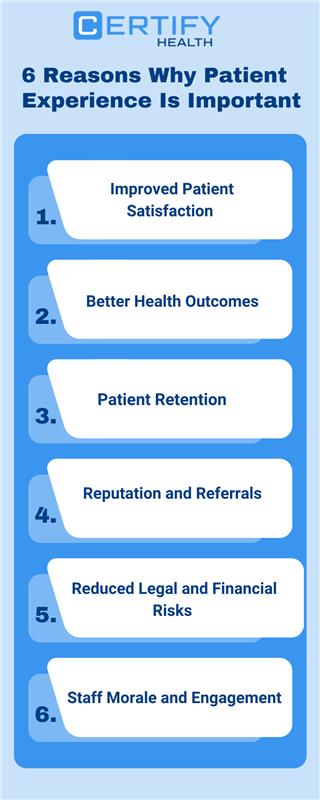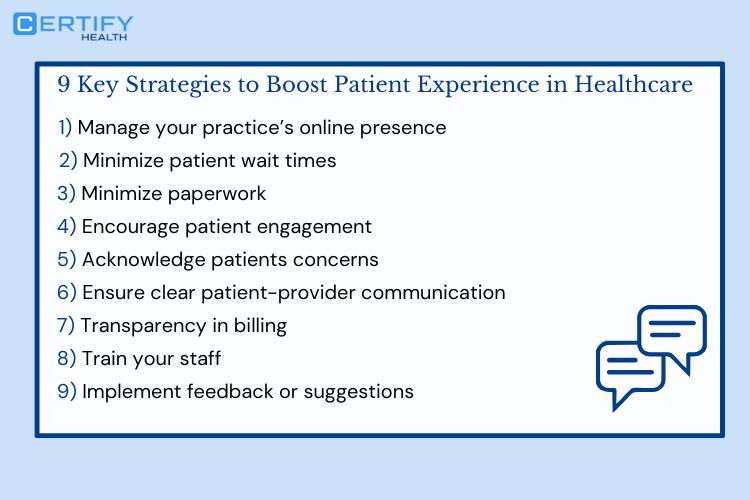What is Patient Experience
People these days prioritize ease and efficiency in all aspects of their lives, and healthcare is no different. They frequently conduct online research before scheduling appointments, to narrow down their options to most suitable healthcare providers.
Patients anticipate a simple and convenient way to schedule appointments, check-in, verify insurance, and make payment through multiple options. Healthcare providers are utilizing technology to simplify operations and enhance patient experience at all stages, from booking to follow-up treatment, in order to meet these expectations.
This article will examine the significance of patient experience and how technology can help to greatly enhance it.
Did you know
Accenture conducted a survey of more than 1,700 people in the U.S. found that two-thirds of patients had negative experience with healthcare providers. Patients said they choose providers who care to listen, clearly explain treatment plans, and provide emotional support.
Why Is Patient Experience Important?

Patient experience definition: Patient experience encompasses their sentiments regarding interactions with healthcare personnel such as doctors, nurses, and administrative staff at each stage of their medical journey.
One might wonder why enhancing the patient experience is crucial.
Individuals today have more options than ever and as previously mentioned, greater expectations from their healthcare providers. As a result, enhancing patient experience has become essential for maintaining competitiveness.
The effect of patient experience on important areas:
1. Quality of Care and Health Outcomes
Patients are more inclined to follow medical advice, stick to treatment schedules, and openly express their concerns and symptoms when they feel appreciated and supported. Healthcare providers can provide more precise diagnoses and personalized treatment because of this openness.
Additionally, a good patient experience encourages patients to participate in preventative care, lowering the risk of problems and enhancing overall well-being.
2. Building Trust and Long-Term Relationships
Trust is essential in healthcare interactions because it influences patient’s faith in their healthcare providers. A positive patient experience enhances trust, which promotes long-term loyalty and a more solid bond with the healthcare providers. It also fosters a sense of security by assuring individuals that they are in the appropriate location to receive the care they require.
Good doctor-patient communication enables more personalized treatment, which makes patients feel heard and respected. As a result, they are more likely to stick with the same provider rather than look for alternatives, which ultimately increases the provider’s revenue and reputation.
3. Enhancing Practice Reputation and Referrals
A good patient experience not only leads to satisfaction, but it influences others as well. Satisfied patients are likely to write positive online reviews, recommend others your healthcare practice, and share experience on social media platforms, boosting credibility.
How does this help? Since today, many rely on word-of-mouth and online reviews, enhancing patient experience strengthens the practice’s reputation and attracts more new patients while retaining existing ones.
4. Finance Benefits, Revenue Growth
A well-managed and smooth patient journey results in reduced patient churn and high retention rates. Not only that, but it also boosts the operational efficiency of your staff allowing them to handle more patients without degrading the quality of care.
Loyal patients with lifetime value continue using provider’s service and contribute to revenue growth by opting for value added services like premium consultations, wellness programs, etc.
Healthcare providers must not overlook compliance and data security. There are strict guidelines like HIPAA, GDPR, and No Surprise Act, made for safety and security of patient data and trust.
But adhering to these guidelines is not so easy, and that’s where come’s the need for patient experiences software. It helps you to adhere to compliance and stay updated with new regulatory requirements automatically. This reduces risk of data breaches, legal violations, and penalties. Patients feel more confident knowing their personal health information is in safe hands.
Financial stability is the backbone of healthcare, yet inefficient billing, insurance verification delays, claim denials and late payments create serious disruptions in revenue cycle management. Without a streamlined revenue cycle, cash flow suffers—impacting operations and patient care.
Patient experience software helps reduce administrative burdens for your staff and automates billing, real-time insurance verification, and digital payment collection, ensuring timely payment collection. Practices can minimize errors, speed up reimbursements, and maintain financial health with a patient experience platform.
Patient provider communication is very important to achieve your patient experience goals. If communication is not proper, it leads to misunderstandings, missed appointments, and compromised treatment outcomes.
The patient experience platform bridges the communication gap between patient and provider by enabling real-time messaging, automated reminders, and access to medical information. It ensures your patients remain engaged throughout their treatment journey.
When communication is seamless, patients feel more connected to their healthcare providers, leading to better relationships, increased trust, and higher satisfaction levels.
9 Key Strategies to Boost Patient Experience in Healthcare

As discussed earlier, in today’s competitive healthcare landscape, enhancing patient experience is of paramount importance. But how do we achieve it? Here are nine key strategies that will help you elevate patient experience within your healthcare practice.
1. Managing Online Presence
A strong online presence is crucial as many patients begin their search for healthcare providers online. Your website and online profiles often form the first impression, influencing a patient’s decision to choose your practice.
Ensure your website and service pages provide updated and accurate information about your services, providers, and contact details. Positive reviews and testimonials can greatly enhance your reputation and attract new patients.
Leverage technology like reputation management tools to monitor and respond to online reviews. Addressing concerns and showcasing positive feedback can significantly improve how potential patients perceive your practice.
2. Minimize Wait Times
Long wait times are one of the most common frustrations among patients, and spending hours in queues can significantly impact their experience. Respecting patients’ time and minimizing delays is key to enhancing patient experience and overall satisfaction.
So, how can you reduce the wait times? Implementing technology like CERTIFY Health’s patient scheduling platform can streamline the process and improve staff efficiency. This software allows patients to self-book appointments, complete necessary forms digitally, and check in seamlessly.
Additionally, patients at the facility receive real-time notifications on their queue number, ensuring they spend less time waiting and more time receiving the care they need.
3. Minimize Paperwork
Your front-desk time spend ample amount of time sorting paperwork from intake forms, insurance verification, and billing. All of these are time-consuming tasks and can frustrate your staff, leading to burnouts.
Burnt out staff are less engaging and empathetic towards patients. When they pay less attention towards patients it impacts patient experience negatively.
Therefore, leverage technology like CERTIFY Health’s patient experience platform that offers solution like digital patient intake, real-time insurance verification, and digital patient payment collection frees up your staff, minimize paperwork, and let them focus more on care and less time on paperwork.
4. Increase Patient Engagement
Engaging patients at different touch points during their healthcare journey is essential for adherence to appointment schedules and treatment plans, which results in better health outcomes and enhance patient experience.
Patients when engaged properly will reduce no-shows and return for follow-up care. How to engage patients? CERTIFY Health’s innovative patient engagement platform increases patient engagement with its omnichannel platform.
Healthcare providers can send personalized text messages or emails to their patients easily through broadcast or through targeted communication. Also, it’s two-way communication feature allows patients and providers to interact with ease enhancing patient experience by giving the care and support at each step of their journey.
5. Clear Communication
Inadequate communication or unclear communication leads to poor patient experience. Patients could not understand their treatment plans, follow-up instructions, and medication details if not communicated clearly.
To enhance patient experience, you need to build trust and strong relationships with your patients so they can open up to you and share their concerns. To foster patient-provider communication, leverage technology like CERTIFY Health.
CERTIFY Health’s patient communication platform enables secure messaging (patients and providers can communicate with ease when they cannot express their concerns verbally), appointment reminders, payment reminders, etc., ensuring patients feel engaged and confident.
6. Understand Their Concerns
To enhance patient experience, one must understand the needs of patients. Regularly conducting surveys and collecting feedback at different touch points of their journey is important to understand their concerns and preferences. This will also help you demonstrate your patient’s preferences and improve your workflow.
Technology enables easy patient feedback collection, providing valuable insights into patient concerns. Use surveys, feedback forms, and online reviews to gather this information and identify areas for improvement.
With the help of CERTIFY Health, your practices can integrate the feedback forms for different stages of the patient journey and collect the feedback securely.
7. Transparent Medical Billing
Your patient received a bill at the end of their treatment, and the amount differed from what it should have been. It can disappoint patients and result in lack of trust in your healthcare practice.
You must tell your patients the cost of treatment upfront and collect the bills during check-in to offer a hassle-free experience. How to ensure transparent medical billing?
CERTIFY Health’s patient payment management tool allows you to do medical billing with ease, collect payment during check-in or through online formats by sending reminders or IVR calls, and ensure transparency and clear bills.
8. Staff Training in Healthcare
Rude or dismissive behavior can make patients feel unhappy with your services and cause them to look for alternative practices. Training staff to be attentive, respectful, and responsive to patient needs is essential.
Regular staff training in healthcare is one of the patient experience strategies you should know. A friendly, empathetic and professional staff can create highly welcoming and supportive environments for patients, which ultimately enhance patient experience.
Invest in face-to-face training to equip your staff with the communication and customer service skills needed to enhance patient experience. Emphasize the significance of active listening, empathy, and problem-solving.
9. Making Changes Based on Requirements
Encourage patients to share their feedback and suggestions for improvement. Genuine and loyal patients often provide valuable insights that can help you enhance your services.
Implementing patient feedback demonstrates that the practice cares for its patients and enhances satisfaction with each visit. Show patients that their voices are heard by making tangible changes based on their input.
Conclusion
Enhance patient experience, strengthen your healthcare practice’s reputation, retain current patients, attract new ones, and improve your revenue cycle. Implement the patient experience strategies outlined in this blog and witness the positive changes yourself.
Utilize technology like CERTIFY Health to differentiate your practice from competitors. Take the Next Step towards transforming your patient experience by exploring how CERTIFY Health can help you achieve your goals.











